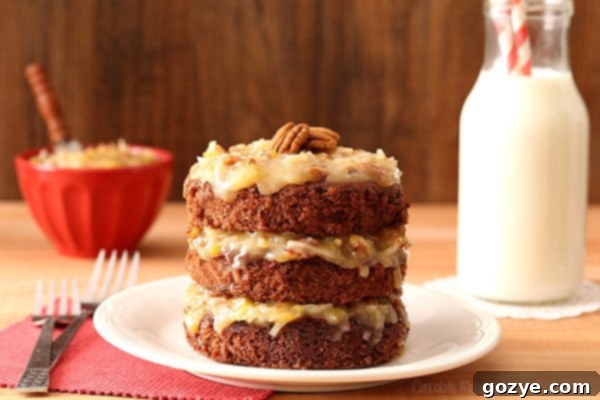Mini German Chocolate Cake Recipe: The Perfect Homemade Dessert for Two
There’s something truly special about a homemade dessert, especially when it’s crafted with love and intended for sharing. This exquisite Mini German Chocolate Cake with Coconut Pecan Frosting is designed to do just that. Baked from scratch, this recipe yields a perfectly portioned cake, ideal for two people to share – or, if you’re feeling indulgent, to enjoy as a generously sized single serving. As February, the month often synonymous with expressions of affection, rolls around, there’s no better way to show someone you care than with a decadent, personalized treat.
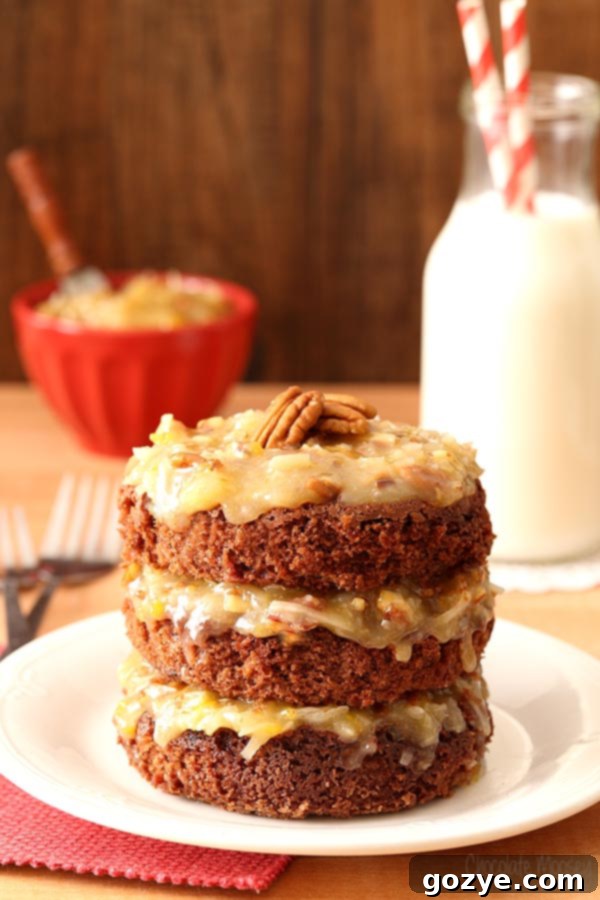
February often brings with it a delightful focus on love, sprinkled with heart-shaped decorations and the aroma of sweet treats. It’s a time when many of us seek opportunities for indulgence, particularly when it comes to rich, chocolaty goodness. While the commercial aspects of Valentine’s Day can sometimes feel overwhelming, the underlying sentiment—celebrating love—is universally cherished. Love, after all, isn’t limited to romantic partners; it extends to friends, family, neighbors, and colleagues. Embracing this broader definition allows us to find joy and connection throughout the month.
For many, myself included, any excuse to enjoy a slice of chocolate cake is a welcome one. And since February has practically become synonymous with chocolate, it felt like the perfect time to craft one of my all-time favorite cakes in an adorable, shareable mini form: a Mini German Chocolate Cake for Two. This isn’t just any chocolate cake; it’s a beautifully layered creation featuring three moist chocolate cake layers generously slathered with homemade coconut pecan frosting. For a touch of modern elegance, I chose to leave the sides unfrosted, creating a stunning “naked” layer cake aesthetic that highlights each delicious layer.
During the recipe testing phase, I actually baked two of these delightful mini cakes, which meant extra treats to share! I ended up enjoying these with my dad and my brother, truly embodying the spirit of family love. Whether you decide to share this cake with a spouse, your parents, a cherished friend, or simply treat yourself, every bite promises a taste of pure, heartwarming affection. It’s a testament to the idea that some of the best gifts are those made with your own hands, from the heart.
Understanding German Chocolate Cake: More Than Just a Name
When you hear “German Chocolate Cake,” you might naturally assume it originates from Germany. However, this delicious dessert is distinctly American. Its name is actually a tribute to an American baker named Samuel German, who in 1852 developed a new, darker baking chocolate for the Baker’s Chocolate Company. This particular chocolate, known as “German’s Sweet Chocolate,” became the key ingredient in the original recipe for what was then called “German’s Chocolate Cake.” Over time, the possessive “‘s” was dropped, leading to the common misconception that the cake had European roots.
The cake’s true inspiration is often linked to the American Texas sheet cake, which also features a rich chocolate cake base paired with a unique coconut pecan frosting. Sam German’s innovation was the creation of a milder, sweeter chocolate (around 48% cacao), making it ideal for baking and distinguishing it from other types of chocolate available at the time. This specific chocolate provides the cake with its characteristic deep chocolate flavor without being overly bitter, laying the perfect foundation for the sweet, custardy coconut pecan topping that truly defines German Chocolate Cake.
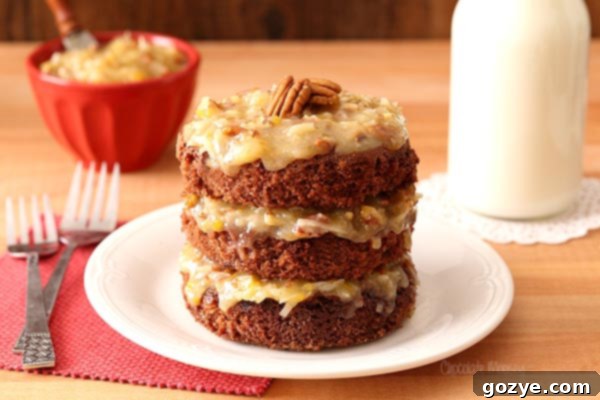
Crafting the Perfect Mini Cake: From One Layer to Three
This Mini German Chocolate Cake for Two initially began as a simple one-layer concept. However, I quickly discovered that the batter wouldn’t fit into a single 4-inch pan without overflowing—a lesson learned the hard way with a rather memorable batter overflow incident! Rather than simply scaling down the recipe to fit one pan, I decided to elevate the design and bake a stunning three-layer cake. This not only added a delightful “wow” factor but also provided more delicious cake to enjoy. The three delicate layers are baked in separate 4-inch springform pans, making them perfectly sized for individual portions before assembly.
If you don’t have three 4-inch springform pans on hand, don’t worry! This versatile recipe can also be adapted for a single 6×2 inch round cake pan. For more specific guidance on baking a slightly larger, yet still small-batch, version, you can refer to my Small German Chocolate Cake post. This adaptability ensures that you can enjoy this decadent treat regardless of your specific bakeware. For those who love the idea of small-batch baking, be sure to explore my other mini cake creations, such as Mini Chocolate Guinness Cake and Mini Peanut Butter Layer Cake.
The Key Difference: German Chocolate Cake vs. Regular Chocolate Cake
The primary distinction between German chocolate cake and a standard chocolate cake lies in the type of baking chocolate used. For an authentic German chocolate cake, you specifically use German’s Sweet Chocolate, which contains approximately 48% cacao. In contrast, most regular chocolate cake recipes call for semi-sweet chocolate, which typically has a higher cacao percentage, usually around 55%. This difference in cacao content significantly impacts the flavor profile and sweetness of the cake.
Cacao percentage indicates how much of the chocolate is derived from pure cacao beans versus how much is added sugar. A higher percentage means more cacao and less sugar, resulting in a more bitter, intense chocolate flavor. Conversely, a lower cacao percentage implies more added sugar, leading to a sweeter chocolate. For example, unsweetened chocolate is 100% cacao—pure, bitter, and generally considered inedible as a snack. Semi-sweet chocolate, at roughly 55% cacao, balances bitterness with sweetness. German’s Sweet Chocolate, with its 48% cacao, is notably sweeter than semi-sweet varieties, imparting a distinctively mild and sweet chocolate flavor to the cake. This inherent sweetness of the chocolate itself is a defining characteristic of German chocolate cake, making it unique from other chocolate cakes.
From extensive baking experience, I can attest that the quality of your ingredients, especially chocolate, profoundly influences the final product. Using high-quality chocolate makes a tangible difference in flavor and texture. It’s a good rule of thumb: if you wouldn’t enjoy eating the chocolate on its own, it likely won’t elevate your cake. Investing a little extra in premium chocolate will truly allow you to taste the superior results in your homemade desserts.
Secrets to a Perfectly Moist German Chocolate Cake
A dry cake is undeniably disappointing, especially when you’ve put effort into baking! The secret to ensuring your German Chocolate Cake remains wonderfully moist and tender lies in one key ingredient: buttermilk. Buttermilk introduces a gentle acidity to the cake batter. This acidity plays a crucial role by reacting with the baking soda, which helps tenderize the cake crumb by breaking down the long, tough strands of gluten. The result is a cake that is exceptionally soft, airy, and moist.
As a small-batch baker, I understand that buying a whole quart of buttermilk for a recipe that only requires a small amount might seem impractical. While sometimes you might find smaller pints, there’s an easy and effective substitute. If you don’t have buttermilk, you can create a suitable alternative using whole dairy milk. Simply add 1 teaspoon of lemon juice or white distilled vinegar for every 1/4 cup of whole milk. Allow the mixture to sit for about 5-10 minutes until it slightly curdles. This acidity is essential for the chemical reaction with the baking soda, ensuring your cake achieves that desired moist and tender texture. Using room temperature milk for this substitute will also yield better results, as cold milk can sometimes cause the batter to seize up.
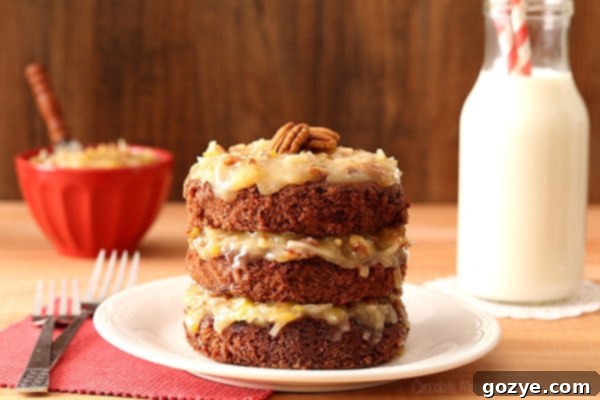
The Irresistible Coconut Pecan Frosting
While the chocolate cake itself is a delight, it’s the iconic coconut pecan frosting that truly defines German Chocolate Cake and often steals the show. This rich, custardy topping is traditionally made with canned evaporated milk, creating a thick, caramel-like base studded with chewy coconut flakes and crunchy pecans. However, for a small-batch recipe like this, opening a full can of evaporated milk for just a small amount might leave you with leftovers. My solution? I opted for heavy whipping cream instead, which I always keep on hand in the fridge.
Using heavy whipping cream yields a similarly rich and creamy frosting, perfectly complementing the sweet chocolate cake. This substitution makes the recipe even more accessible for home bakers, ensuring you can create this decadent frosting without specialized ingredients. The combination of the sweet, nutty pecans and the tender, tropical coconut creates a textural and flavor contrast that is simply irresistible against the moist chocolate cake. For the full, detailed recipe for this luscious topping, make sure to check out my dedicated Small Batch German Chocolate Frosting post!
Essential Tools for Your Mini German Chocolate Cake
To successfully bake this delightful mini cake, having the right tools can make all the difference. Here are a few items you might find helpful (Amazon affiliate links):
Explore More German Chocolate Delights
If you’re a fan of the classic flavors of German Chocolate Cake, you’ll be thrilled to know that this delightful profile of chocolate, coconut, and pecan can be incorporated into a variety of other delicious desserts. Expand your baking repertoire with these creative German Chocolate-inspired recipes:
- German Chocolate Cheesecake: A creamy, rich cheesecake with the signature coconut pecan topping.
- German Chocolate Pecan Pie: A southern classic infused with the sweet chocolate and nutty elements of German chocolate cake.
- German Chocolate Ice Cream: Enjoy the flavors of your favorite cake in a cold, refreshing scoop.
- German Chocolate Cookies: Chewy cookies filled with the familiar sweet and nutty topping.
- German Chocolate Cheese Ball: A sweet and decadent spread, perfect for entertaining.
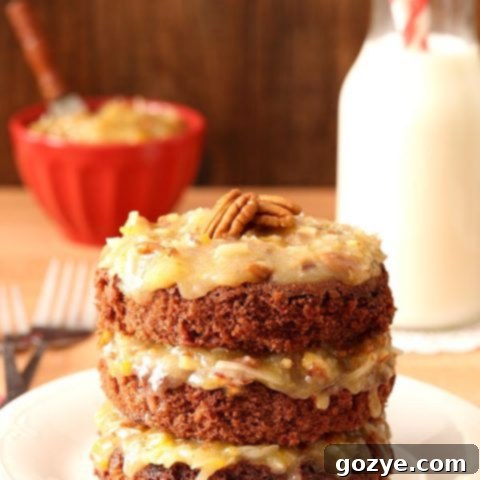
Mini German Chocolate Cake For Two
2-4 servings
30 minutes
20 minutes
50 minutes
Delight someone special with this homemade Mini German Chocolate Cake, featuring rich chocolate layers and an irresistible coconut pecan frosting. This recipe is perfectly portioned for two, making it an ideal dessert for intimate celebrations or a sweet treat to share.
Ingredients
- 1 ounce German baking chocolate, chopped
- 1/2 cup all-purpose flour
- 1/4 teaspoon baking soda
- 1/8 teaspoon salt
- 1/4 cup unsalted butter, softened
- 1/2 cup granulated sugar
- 1 egg, room temperature
- 1/4 teaspoon vanilla extract
- 1/4 cup buttermilk or whole milk with 1 teaspoon lemon juice added, room temperature
- 2 tablespoons prepared coffee or water, room temperature
- 1 recipe Small Batch German Chocolate Frosting (get the recipe here)
Instructions
- Preheat your oven to 350°F (175°C). Lightly grease and flour three 4-inch springform pans. Place these pans on a baking sheet to ensure even heat distribution and easy handling.
- In a large heatproof bowl, melt the chopped German baking chocolate over a pan of simmering water (ensure the bowl does not touch the water). Once melted and smooth, remove the bowl from the heat and allow the chocolate to cool for about 15 minutes. This prevents it from cooking the egg when added.
- In a separate medium bowl, whisk together the dry ingredients: all-purpose flour, baking soda, and salt. Set aside.
- Combine the buttermilk (or your homemade buttermilk substitute) with the prepared coffee or water in a measuring cup. Ensure both are at room temperature.
- In a large mixing bowl, using an electric mixer, beat together the softened unsalted butter and granulated sugar until the mixture is light, fluffy, and creamy, typically about 2 minutes. This creaming process incorporates air, contributing to the cake’s tender texture.
- Add the room temperature egg and vanilla extract to the butter and sugar mixture, beating for an additional minute until well combined. Then, beat in the cooled melted chocolate until fully incorporated.
- Gradually add the flour mixture and the buttermilk mixture to the wet ingredients in three alternating additions, starting and ending with the flour mixture. Mix on low speed until just combined. For the final flour addition, turn off the mixer and gently fold by hand to avoid overmixing, which can lead to a tough cake.
- Divide the cake batter evenly among the three prepared 4-inch pans. Gently tap each pan a few times against the counter to release any trapped air bubbles. Bake for 20-25 minutes, or until a toothpick inserted into the center of each cake comes out clean. Let the cakes cool completely in their pans on a wire rack before running a knife along the edges and unmolding them.
- While your cake layers are baking and cooling, prepare the Small Batch German Chocolate Frosting according to its dedicated recipe (find the instructions here). Ensure the frosting is also completely cooled before assembling the cake.
- If your cake layers have slightly rounded tops, use a serrated knife to carefully level them, creating flat surfaces for easier stacking. Place one cake layer on your chosen serving plate or cake stand. Spread a generous amount of the cooled coconut pecan frosting evenly over the top. Carefully place the second cake layer on top, spread with more frosting, and then top with the final cake layer. Finish with a final layer of frosting on top, creating a beautiful “naked” effect by leaving the sides unfrosted. Serve and enjoy!
Notes
- **No 4-inch pans? No problem!** If you don’t have three 4-inch springform pans, you can bake this recipe in a single 6-inch round cake pan. Baking time may vary slightly, so check for doneness with a toothpick. For specific instructions on how to adapt the recipe, refer to my 6 Inch Small German Chocolate Cake recipe.
- **Buttermilk substitute:** If you don’t have buttermilk, you can make your own! For 1/4 cup whole milk, stir in 1 teaspoon of lemon juice or white vinegar. Let it sit for 5-10 minutes until it slightly curdles.
- **Room temperature ingredients:** Ensure your butter, egg, buttermilk (or substitute), and coffee/water are at room temperature. This helps create a smooth, emulsified batter and contributes to a finer crumb structure.
- **Don’t overmix:** Overmixing the batter can develop the gluten too much, resulting in a tough cake. Mix until just combined.
- **Loved this cake?** Explore more small-batch and mini cake recipes! Check out my Mini Chocolate Guinness Cake and Mini Peanut Butter Cake for other delightful small desserts.
Recommended Products
As an Amazon Associate and member of other affiliate programs, I earn from qualifying purchases.
- 4-Inch Springform Pans
- Offset Spatula
Did you make this recipe?
Let me know what you think! Rate the recipe above, leave a comment below, and/or share a photo on Instagram using #HITKrecipes
